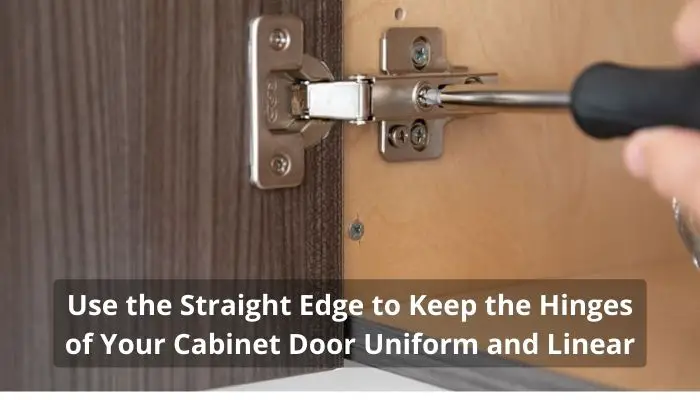How to Measure Cabinet Door Hinge Placement? 4 Easy Steps to Follow
When it comes to measuring cabinet door hinge placement, there’s no definitive answer to it. However, we can look at the standard measurement practices to help with a successful hinge placement on the cabinet door.

How to measure cabinet door hinge placement? We’d say the standard approach would be to place the hinges closer to the top and bottom of the inside edge of your cabinet door so that they put less stress on the hinges. This way, the hinges will be better positioned to counteract the propensity to pivot. The taller doors will require one or two hinges in the middle, aside from the top and bottom ones.
How to get all the exact measurements? The cabinet door hinge placement guide here has the answer so that every DIY enthusiast knows how to place the hinges without errors!
How To Measure Cabinet Door Hinge Placement?
How do you measure for cabinet hinges? Follow a few simple steps below to measure the cabinet door hinge placement successfully.
Step 1: Place the Cabinet Door
Place the door face down on a smooth, flat surface with the handle side facing the floor and the hinges side facing you. Make sure to work in a clean area, so the door surface doesn’t get scratches or marks.
Step 2: Measure the Height & Weight to Decide the Number of Hinges
There’s no standard size for cabinet doors, so you first have to measure the height and weight of your door. The number of hinges to place on a door depends on height and weight.

You should know these measurements from the product specifications. If you still don’t find it, use a measuring tape to measure the height and a weighing scale for the weight.
If the door height is less than 40 inches and the weight is less than 11 lbs, you’ll have to use two hinges; one at the top and one at the bottom of the inward door edge.
For a height range of 40 to 60 inches and a weight range of 13 to 20 lbs, you’ve to use three evenly placed hinges on the inside edge of your cabinet door; one at the top, one at the middle, and one at the bottom. Any measurement more than that (which is less common) will require four evenly distributed hinges.
Step 3: For Standard Cabinets, Consider Two Hinges
The height of the cabinet could vary; however, the standard cabinets are 30 to 36 inches tall. So, according to the above rules, you can go with two hinges, one at the top and one at the bottom.
Step 4: Measure and Mark a Distance from the Top & Bottom Edge
Finally, you can measure and mark the placement to set up your door hinges. Consider the following two instances.
For Standard Two Hinges Cabinet Doors
Use measuring tape or ruler to measure the most suitable space from the top and bottom of your cabinet door edge. The average space for a standard cabinet door with two hinges from each end is around 3 to 3.5 inches.
For a 30 inches door, hold the hinges at a length of 3 inches from both ends. Then use a pencil to mark that hinge placement. And for a 36 inches distance, measure a length of 3.5 inches from each end, hold the hinges, and mark the placements using a pencil.
Mark a horizontal line for both these measurements and ensure both markings are evenly positioned. It’ll make sure the door opens and closes without any problem.
For Different Height Doors
If you’ve got a taller door, a moderate difference to the above measurement won’t make any difference to the hinges’ stress. But you may have to add one or two hinges evenly in the middle of the top and bottom hinges based on the height.
But for shorter doors like those over range hoods, the above approach could cause sagged hinges because the hinges can come too close to each other. In that case, consider a length of 2 inches or less from the top and bottom edge of your cabinet door and mark accordingly.
Importance Of Perfect Measurement For Cabinet Door Hinge Placement
It’s very important to measure the placement of cabinet door hinges perfectly regardless of the types of hinges for cabinets you use. The reasons why hinge placement measurement needs to be perfect are:

- The placement of hinges can affect the direction of your door’s swing.
- The door casing can deform and lose parallelism; as a result, the door could open and close unevenly.
- Imperfect placement can impede perfect door closure, and you may even see your cabinet doors won’t close after painting or varnishing.
- Wrong hinge placement can lead to sagged hinges that may jam up during the movement of the door leaf.
Tips To Follow When Measuring Cabinet Door Hinge Placement
Let’s discuss some tips you can follow to measure the placement of your cabinet door hinges perfectly.

- Use the straight edge to keep the hinges of your cabinet door consistent and linear.
- Never use a single hinge regardless of the size of the door.
- Take assistance while holding and marking the hinge at the placement, or you can also clamp it. Because you may find it difficult to do alone, which can lead to a wrong measurement
- You can place a towel or cushion on the floor of the working area as it’ll ensure that the side of the door facing the floor remains undamaged.
- The instructions above consider standard-sized cabinet hinges like 26mm and 35mm. If unsure about your desired hinges size, measure the cabinet hinges overlay for the right size. The instructions might vary slightly in that case.
Final words
Where should cabinet door hinges be placed? You probably have your answer by now.
If you’ve got a lightweight, average size cabinet door, 2 hinges with spacing around 3 inches from each end should be alright. Shorter doors will require less spacing (two inches or less) to perform smoothly. But if the doors are taller or heavier, they’ll most likely need an extra hinge in the center of both hinges (on the edge) to provide more stability.
Besides perfectly measuring the hinge placement, you must also find the right hinge type. European or hidden hinges make a very popular choice. Many like to install hidden hinges on face frame cabinets, while others like them on frameless ones.
Full overlay, half overlay, and inset hinges are also popular. Blum hinges have become a favorite brand of hinges for DIY carpenters. If you already have one, but don’t know how to adjust Blum hinges, check out the article here.




